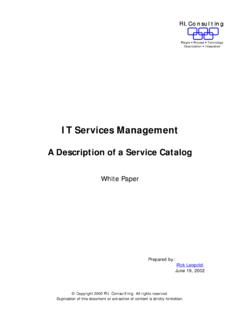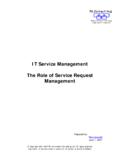Transcription of A practical guide to ITSM and ITIL 3 3 - BarclayRae …
1 A practical guide to IT Service Management and ITIL v3 Part 1 Moments of Truth a practical guide to itsm & ITIL v3 Part 1 Moments of Truth 2 The Report Author is Barclay Rae, Professional services Director, HDI. Barclay has over 25 years experience in the Service Management industry. Help Desk Institute November 2007 a practical guide to itsm & ITIL v3 Part 1 Moments of Truth 3 Introduction Cards on the table This guide is written from (my) personal perspective of operational and consulting experience in service management going back to 1982, involving over 300 service-change projects. In many of these projects I ve used ITIL (and other best practice approaches, or elements of them), to varying degrees from full-on implementations to some tangential uses of the key elements of ITIL.
2 In most of these projects I ve done very little ITIL work and most of what I do is not really ITIL implementation everything but. What I get involved in is classic consultancy, analysis and mentoring around structure, management, planning, culture-change, motivation, project management, business case development, customer surveying, account management, internal marketing and communications, event management, teambuilding, workshops, presentation and facilitation, personal development and coaching, negotiation, conciliation, recruitment and many other disciplines. All of these areas are generally handled in relation to service management; however, whilst I do a fair amount of process development, mapping, implementation and training, none of the above disciplines are actually the stuff of the legacy ITIL books.
3 Yet these areas are, in my experience, the real activities and content of what is needed to make service improvement successful. The ITIL approach does incorporate some of this activity but this is now in danger of becoming an over-wieldy approach. This is not about ITIL, it s about service management. Service management being the term we use to describe the business of managing your organisation to deliver professional, accountable, consistent levels of service seems obvious? The key is that we are not talking about a methodology, or a rigid prescriptive approach (these are bad implementations of ITIL). What is required is a co-ordinated approach from an organisation that usually requires some major culture and organisational change to be really effective. What we are aiming to do is to define ways in which IT/service organisations can develop the quality of their service offerings, to directly support and enhance their business objectives.
4 ITIL can be applied to most of these situations, either explicitly or implicitly and as such is a highly useful tool however it is not an end in itself and should not be seen as a panacea that will sort out all problems. What I have done for many years is to help to fill in the gaps that ITIL doesn t cover (as suggested above structure, people, communications, culture etc). It s true that the new books now mention most of these areas as issues that need to be addressed it s just that ITIL can t provide all the answers. Generally if you are well taught when doing your ITIL training, you will appreciate these issues, but this still doesn t give you a blueprint for how to really effect change in your organisation, and that is the aim of this paper. a practical guide to itsm & ITIL v3 Part 1 Moments of Truth 4 I would generally say (wouldn t I?)
5 !) that external help is valuable for a number of reasons to provide key skills and resources, to give an unbiased viewpoint, to mentor, to fast track projects etc. However, once you have real information and knowledge of how to make this work, plus the resources and backing, there is no reason why this cannot be achieved as an internal project. This paper uses 25 years service management experience to provide simple and clear answers and guidance to these questions (and more), in order to provide a practical and pragmatic approach to delivering successful service management. I hope this can help you and wish you good luck! Barclay Rae a practical guide to itsm & ITIL v3 Part 1 Moments of Truth 5 1 Where do we start? Questions, Questions, We work hard trying to deliver a good service to our customers, yet we get all this stuff from the industry, our peers and management about why we should be doing better, doing best practice , demonstrating value and accountability, doing more for less, doing ITIL, getting accreditation etc how relevant is all this to our business and operation?
6 Why do we need to do these things? What value will they deliver to our customers, our department, to our organisation as a whole, and to us as individuals? What will all this cost, how long will it take, what and who will need to be involved? Do we have the right people and skills in-house or do we need to bring in expensive consultants to do this or help us why can t we do this by ourselves? How do we approach this we read the books about the end-game and how the operation and process structure should all hang together, but how do we get there? How do we build a suitable and successful business case for this, and how can we demonstrate that our project has been successful? Is there a standard prescribed way to implement ITIL and itsm ? Is there an order of processes that must be adhered to?
7 Can we apply some specific processes only or do we have to implement all of the ITIL modules to achieve the benefits promised? Why should we follow an approach that seems to be rooted in internal IT only, when nowadays most support organisations are run as multi-sourced operations? In many cases ITIL doesn t seem to speak to us in a meaningful language, as we don t really fit the model that it s written for why should we follow this? We hear these questions practically every day, from a wide variety of people across industries and at different levels of staff and management. People ask these questions for a number of different reasons, depending on where they are in terms of the maturity of their operation, or their position in terms of running a Service Improvement Project. In many cases they are looking at doing some form of best practice project but need to be convinced of the benefits and they also need to understand the full extent of what they are taking on (time, resources and costs).
8 In other cases they are in the middle of a project and are getting into difficulty, or facing resistance and blockages from their organisation, or they simply need guidance on how to make the ITIL/ itsm model work in practical terms. Sometimes they are senior managers who have seen a lot of time and money spent without any real tangible improvement, or clear business benefit, others may simply be looking for clarity from the vast body of work that exists on approach, processes and integration. a practical guide to itsm & ITIL v3 Part 1 Moments of Truth 6 What we find is that people are, on the one hand crying out for the solutions and answers that ITIL and itsm promises, but are in reality still really struggling to find practical advice on this through the maze of books, articles and industry publications, plus advice from industry experts and gurus.
9 So, where do we start? Service Management Most organisations evolve organically, regardless of function. Even the most forward thinking teams, departments or businesses cannot predict exactly what will happen to them in future and there will always be the need for change. From a service perspective most service operations have also developed organically in response to the needs of the business they support. IT help desks evolved in the 1980s for various reasons (one being that companies like IBM offered discounts to their customers if they operated a single point of contact help desk!). These help desk teams soon found that their problem was often not so much dealing with their customers, but being able to get help from their own (IT) department. The point being here that, in the evolved organic organisation, people both in IT and the business had found ways of working and communicating with each other that worked (well sort of).
10 Informal service relationships are often flawed, inconsistent, inefficient, expensive and unaccountable, but to the people involved, they often worked help desks just messed up this system!? a practical guide to itsm & ITIL v3 Part 1 Moments of Truth 7 The reality of course was that many early (and even some current) help desks were simply by-passed by their customers and IT colleagues alike, thereby missing the opportunity to reduce the support overhead on technical staff, develop standard procedures and reporting, and to provide visibility to management on service activity. In many cases this also meant that IT was not actually meeting the business needs of its customers as support priorities were based on cherry-picking, or who shouts loudest, or the old boy network, rather than the agreed business imperatives.







